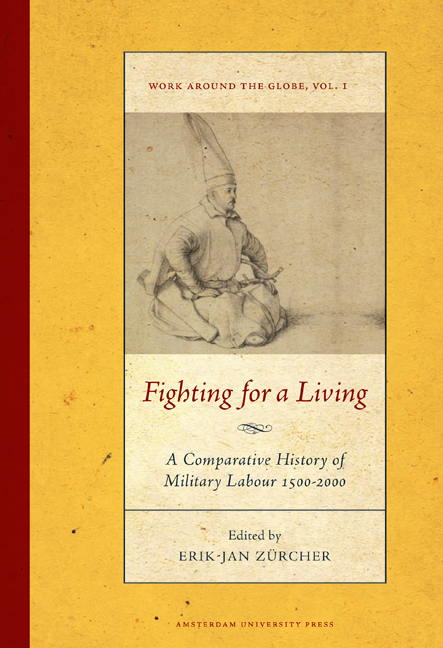Book contents
- Frontmatter
- Dedication
- Contents
- Preface
- Introduction: Understanding Changes in Military Recruitment and Employment Worldwide
- Military Labor in China, c. 1500
- From the Mamluks to the Mansabdars: A Social History of Military Service in South Asia, c. 1500 to c. 1650
- On the Ottoman Janissaries (Fourteenth-nineteenth Centuries)
- Soldiers in Western Europe, c. 1500-17901
- The Scottish Mercenary as a Migrant Labourer in Europe, 1550-1650
- Change and Continuity in Mercenary Armies: Central Europe, 1650-1750
- Peasants Fighting for a Living in Early Modern North India
- “True to Their Salt”: Mechanisms for Recruiting and Managing Military Labour in the Army of the East India Company During the Carnatic Wars in India
- “The Scum of Every County, the Refuse of Mankind”: Recruiting the British Army in the Eighteenth Century
- Mobilization of Warrior Populations in the Ottoman Context, 1750-1850
- Military Employment in Qing Dynasty China
- Military Service and the Russian Social Order, 1649-1861
- The French army, 1789-1914: Volunteers, Pressed Soldiers, and Conscripts
- The Dutch Army in Transition: From All-volunteer Force to Cadre-militia Army, 1795-1830
- The Draft and Draftees in Italy, 1861-1914
- Nation-building, War Experiences, and European Models: The Rejection of Conscription in Britain
- Mobilizing Military Labor in the Age of Total War: Ottoman Conscription Before and During the Great War
- Soldiering as Work: The All-volunteer Force in the United States
- Private Contractors in War From the 1990s to the Present: A Review Essay
- Collective Bibliography
- Notes on Contributors
Preface
Published online by Cambridge University Press: 12 December 2020
- Frontmatter
- Dedication
- Contents
- Preface
- Introduction: Understanding Changes in Military Recruitment and Employment Worldwide
- Military Labor in China, c. 1500
- From the Mamluks to the Mansabdars: A Social History of Military Service in South Asia, c. 1500 to c. 1650
- On the Ottoman Janissaries (Fourteenth-nineteenth Centuries)
- Soldiers in Western Europe, c. 1500-17901
- The Scottish Mercenary as a Migrant Labourer in Europe, 1550-1650
- Change and Continuity in Mercenary Armies: Central Europe, 1650-1750
- Peasants Fighting for a Living in Early Modern North India
- “True to Their Salt”: Mechanisms for Recruiting and Managing Military Labour in the Army of the East India Company During the Carnatic Wars in India
- “The Scum of Every County, the Refuse of Mankind”: Recruiting the British Army in the Eighteenth Century
- Mobilization of Warrior Populations in the Ottoman Context, 1750-1850
- Military Employment in Qing Dynasty China
- Military Service and the Russian Social Order, 1649-1861
- The French army, 1789-1914: Volunteers, Pressed Soldiers, and Conscripts
- The Dutch Army in Transition: From All-volunteer Force to Cadre-militia Army, 1795-1830
- The Draft and Draftees in Italy, 1861-1914
- Nation-building, War Experiences, and European Models: The Rejection of Conscription in Britain
- Mobilizing Military Labor in the Age of Total War: Ottoman Conscription Before and During the Great War
- Soldiering as Work: The All-volunteer Force in the United States
- Private Contractors in War From the 1990s to the Present: A Review Essay
- Collective Bibliography
- Notes on Contributors
Summary
He's five-foot-two, and he's six-feet-four,
He fights with missiles and with spears.
He's all of thirty-one, and he's only seventeen,
He's been a soldier for a thousand years.
…
He's the one who gives his body
As a weapon of the war,
And without him all this killing can't go on.
– Buffy Sainte-Marie, “Universal Soldier” (1964)This pioneering volume is a remarkable international attempt to bridge the gap between military history and labour history, by exploring the labour of the military as a subject in its own right. During 2009-2012, a team of twenty researchers from nine countries led by Erik-Jan Zürcher systematically reconstructed the similarities and differences between military recruitment and employment systems in Asia and Europe from the sixteenth century onwards. Their comparative approach has made it possible to discover general historical patterns. In turn, these patterns suggest causal relationships which could, should, and no doubt will be the subject of more in-depth studies in the future.
Until now, military historians and labour historians inhabited separate worlds. Military historians were concerned with wars, military doctrines, arms technology, campaign logistics, and similar issues. For them, soldiers usually enter into the picture as the executors of commands, and, in the narrative of military historians, what decides the outcome of battles are the numbers, skills, weaponry and morale of the combatants. Labour historians by contrast regard soldiers above all as the oppressors of labour resistance, who sometimes – in revolutionary situations – change sides and join the workers. According to many labour historians, what soldiers do as soldiers is not “work” – since work is constructive, not destructive – but instead a kind of “anti-work”. The military are indeed conventionally excluded from “the labour force”, and therefore they are not counted in labour force statistics.
The idea that what soldiers do “cannot be work” is a moralistic prejudice, however. Work is the purposeful production of useful objects or services. Thus, work is a purposive activity, and work creates objects or services that are useful to the people for whom the work is done. That makes participation in military activities just as much a labour process as any other, even if many civilians do not regard it as a “useful activity” and have no use for it.
- Type
- Chapter
- Information
- Fighting for a LivingA Comparative Study of Military Labour 1500–2000, pp. 9 - 10Publisher: Amsterdam University PressPrint publication year: 2013
- 1
- Cited by



